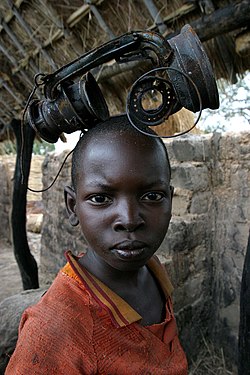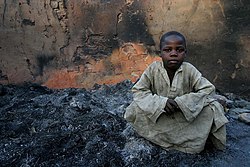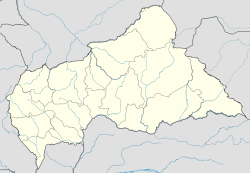Birao
 From Wikipedia - Reading time: 12 min
From Wikipedia - Reading time: 12 min
Birao | |
|---|---|
 Birao after being burnt down in 2007 | |
Map of the Central African Republic | |
| Coordinates: 10°17′38″N 22°46′55″E / 10.294°N 22.782°E | |
| Country | |
| Prefecture | Vakaga |
| Government | |
| • Sub-Prefect | Babakri Djabaldine Nzangue[1] |
| • Mayor | Sultan Hamat Moustapha Angabo[2] |
| Elevation | 468 m (1,536 ft) |
| Population (2012) | |
• Total | 10,178 |

Birao is the capital of Vakaga, one of the 14 prefectures of the Central African Republic and was an administrative post in the colony of Ubangui-Shari.[3] In March 2007, the town was almost completely burnt down in the fighting between rebels and government troops in the area.
History
[edit]Colonial Period
[edit]Birao was founded on 6 November 1918 by the French colonial government as its northernmost post in Ubangi-Shari.[4][5][6]
Under Bokassa
[edit]Jean-Bédel Bokassa, the military ruler of the Central African Republic in the 1960s and 1970s, sent the family of Alexandre Banza to Birao after Banza attempted to overthrow him. Birao was isolated from the rest of the country and Banza's family was monitored by Bokassa. Banza's wife and nine children were kept in Birao until 1970. Beouane and Goboulo, Banza's two brothers, were also kept in Birao, but were soon imprisoned.[7]
Birao was considered an undesirable place to be sent; the "disciplinary cells" in the Ngaragba Prison run by Bokassa were called Birao.[8] Later, after Bokassa had fallen from power and his execution sentence had been commuted, sending Bokassa to Birao was considered a possibility because the remote location of the place would separate him from his political allies.[9]
Central African Republic Bush War
[edit]In November 2004, at least 20 people were killed in a raid on the remote town of Birao in the north-east of the Central African Republic.[10]
2006
[edit]On October 29, 2006, a force of around 150 rebels took the town of Birao, which is close to the border with Sudan and Chad. The rebels from the UFDR movement say some government troops joined them, and others were taken prisoner. The CAR government accused Sudan of being behind that attack.[11]
On November 14, France, the traditional backer of the CAR government, offered the CAR military assistance in the form of logistics and aerial reconnaissance. France already had a regular 200-soldier contingent in the CAR supplementing the 5,000-soldier army of the CAR itself.[12] On that day, the UFDR announced that they had suspended military activities in favour of negotiations.[13]
On November 17, Chad's parliament approved troop deployment to the CAR.[14] The CAR government appealed to the United Nations to send troops,[15] and United Nations Secretary-General Kofi Annan called for the attacks in CAR's border with Darfur to end.[16] Chad's decision to deploy troops to the CAR came as hopes for a deal with Sudan over peacekeeping forces in Darfur proved premature.[17][18]
On December 14, France admitted having performed air raids against UFDR positions since the beginning of December, employing Mirage F1 fighters and helicopter gunships, and including an attack on the UFDR-controlled town of Birao. French Defence Ministry spokesman said the action was "in line with international calls to stabilise the region". UFDR reports claim that the raids had a devastating effect on the civilian population.[19]
2007
[edit]
On April 13, 2007, a peace agreement between the government and the UFDR was signed in Birao. The agreement provides for an amnesty for the UFDR, its recognition as a political party, and the integration of its fighters into the army.[20]
In March 2007, the Union of Democratic Forces for Unity attacked the French army and the armed forces of the Central African Republic (FACA), which held Birao at the time.[21] Students who used to attend the secondary school in Birao were in the UFDR forces.[21]
Later fighting
[edit]On 10 October 2010, LRA invaded Birao. They looted the main market and kidnapped nine children.[22] On November 15, 2010, United Nations forces returned control of Birao to the government of the Central African Republic.[23] Later in November, a rebel group called the Convention of Patriots for Justice and Peace captured Birao.[23] On December 1, 2010, Birao was captured by the army of Chad, on behalf of the government of the Central African Republic. In September 2011, LRA attacked Birao and abducted 12 girls and 5 boys.[24]
On 26 June 2014 international forces left Birao following ultimatum by Popular Front for the Rebirth of Central African Republic (FPRC) armed group.[25] On 14 July 2019 clashes erupted between Movement of Central African Liberators for Justice (MLCJ) and FPRC in Birao after two people were arrested by FPRC fighters four days before. Four FPRC militiamen were killed and the two individuals were subsequently executed. On 1 September MLCJ attacked FPRC positions in Birao leading to 23 FPRC and eight MLCJ fighters being killed. The following day the town was captured by MLCJ. On 14 September FPRC attacked Birao which was repelled. 37 FPRC and 11 MLCJ fighters were killed.[26] On February 17, 2020, members of the Popular Front for the Rebirth of Central Africa (FPRC) attacked MINUSCA forces in Birao, leading to 12 FPRC militants being killed.[27] On 15 March 2022 Russian mercenaries from Wagner Group temporarily entered Birao before returning to N'dele.[28] On 7 December 2022 Russians supported by armed forces established permanent base in Birao.[29]
Climate
[edit]Birao has a hot semi-arid climate (Köppen BSh), more akin to N'Djamena or Niamey than to the rest of the Central African Republic. The city is hot to sweltering throughout the year, with every month having an average maximum over 30 °C or 86 °F, and the period before the wet season breaks in March and April sees average maxima reach a sweltering 39.7 °C or 103.5 °F. The wet season lasts from May to September, peaking in July and August, and is cooler by day than the long dry season but just as uncomfortable due to the higher humidity.
| Climate data for Birao | |||||||||||||
|---|---|---|---|---|---|---|---|---|---|---|---|---|---|
| Month | Jan | Feb | Mar | Apr | May | Jun | Jul | Aug | Sep | Oct | Nov | Dec | Year |
| Mean daily maximum °C (°F) | 34.7 (94.5) |
37.3 (99.1) |
39.4 (102.9) |
39.7 (103.5) |
37.9 (100.2) |
35 (95) |
31.4 (88.5) |
30.8 (87.4) |
32.1 (89.8) |
34.5 (94.1) |
35 (95) |
33.6 (92.5) |
35.1 (95.2) |
| Daily mean °C (°F) | 23.7 (74.7) |
26 (79) |
28.8 (83.8) |
30.4 (86.7) |
30.2 (86.4) |
28.3 (82.9) |
25.7 (78.3) |
25.3 (77.5) |
25.9 (78.6) |
26.5 (79.7) |
23.9 (75.0) |
22.5 (72.5) |
26.4 (79.6) |
| Mean daily minimum °C (°F) | 12.7 (54.9) |
14.8 (58.6) |
18.3 (64.9) |
21.1 (70.0) |
22.5 (72.5) |
21.6 (70.9) |
20.1 (68.2) |
19.8 (67.6) |
19.7 (67.5) |
18.6 (65.5) |
12.8 (55.0) |
11.4 (52.5) |
17.8 (64.0) |
| Average rainfall mm (inches) | 0 (0) |
0 (0) |
1 (0.0) |
20 (0.8) |
67 (2.6) |
107 (4.2) |
189 (7.4) |
193 (7.6) |
146 (5.7) |
38 (1.5) |
1 (0.0) |
0 (0) |
762 (29.8) |
| Source: Climate-Data.org[30] | |||||||||||||
Education
[edit]Birao has primary schools and high schools. Unfortunately, the town faces a scarcity of qualified teachers and an inadequate number of schools for the population.[31]
Security
[edit]FACA soldiers are present in Birao and they suffer from logistical issues. The town residents own their personal weapons due to the dire security conditions.[31][32]
Transport
[edit]Donkeys and horses are the main transportation modes in the town, especially on rainy sessions when many roads are inaccessible. The majority of town residents prefer donkey since it is cheap and easy to take care. Road conditions connecting to the town are terrible. Rebel presence along the road is the main factor behind the failure of road rehabilitation.[33]
See also
[edit]Notes
[edit]- ^ Oubangui Medias, Oubangui Medias. "Centrafrique : Décrets portant nomination des Gouverneurs, des Préfets et des Sous-Préfets". oubanguimedias.com. Oubangui Medias. Retrieved 6 June 2024.
- ^ ""Les Forces armées centrafricaines sont limitées à Birao par manque de moyens de déplacement"". 7 April 2022.
- ^ Kalck pg.24
- ^ Rius, Juan Fandos; Bradshaw, Richard (2016). Historical Dictionary of the Central African Republic. Maryland: Rowman & Littlefield. p. 120. ISBN 9780810879928.
- ^ Serre, Jacques; Fandos-Rius, Juan (2014). Répertoire de l'administration territoriale de la République centrafricaine. Paris: L’Harmattan. p. 64. ISBN 978-2-343-01298-8.
- ^ Serre, Jacques; Fandos-Rius, Juan (2014). Répertoire de l'administration territoriale de la République centrafricaine. Paris: L’Harmattan. p. 166. ISBN 978-2-343-01298-8.
- ^ Titley, pg. 34
- ^ Titley, pg. 37
- ^ Titley, pg. 203
- ^ "Raid on CAR town 'leaves 20 dead'". BBC. 2004-11-23. Retrieved 2016-04-12.
- ^ "CAR rebels seize town near Chad". BBC. 2006-10-30. Retrieved 2016-04-12.
- ^ "France renders last minute support to Central African Republic", Afrol News, November 14, 2006
- ^ "CAR rebels make fresh call for talk", Independent Online, November 14, 2006
- ^ "Chadian parliament votes in favor of troop deployment to Central African Republic", November 17, 2006
- ^ "Central Africa's Bozize asks EU to push for UN troops"[dead link], Reuters, November 17, 2006
- ^ "Annan Urges End to Attacks Near Central African Republic's Border", United Nations, November 11, 2006
- ^ "US Rice hopes Sudan will okay Darfur force" Archived 2016-10-03 at the Wayback Machine, Sudan Tribune, November 17, 2006
- ^ "Sudan 'did not' give ok over international force for Darfur - top official" Archived 2008-04-11 at the Wayback Machine, Kuwait News Agency, November 17, 2006
- ^ "France admits air raids on Darfur neighbours" Archived July 24, 2008, at the Wayback Machine, The Independent, 15 December 2006
- ^ "Central African Republic, rebels sign peace deal", Associated Press (USA Today), April 13, 2007.
- ^ a b Report of the Committee of Experts on the Application of Conventions and Recommendations (articles 19, 22 and 35 of the Constitution): Third Item on the Agenda: Information and Reports on the Application of Conventions and Recommendations. International Labour Organization. 2010. ISBN 978-92-2-121879-1.
- ^ MINUSCA (May 2017). Report of the Mapping Project documenting serious violations of international human rights law and international humanitarian law committed within the territory of Central African Republic between January 2003 and December 2015 (PDF) (Report). MINUSCA. p. 111. Retrieved 28 December 2022.
- ^ a b Thurston, Alex. "Renewed Violence Prompts Concern in Central African Republic." Africa Monitor. The Christian Science Monitor, 3 Dec. 2010. Web. 10 Dec. 2010. <http://www.csmonitor.com/World/Africa/Africa-Monitor/2010/1203/Renewed-violence-prompts-concern-in-Central-African-Republic>.
- ^ MINUSCA (May 2017). Report of the Mapping Project documenting serious violations of international human rights law and international humanitarian law committed within the territory of Central African Republic between January 2003 and December 2015 (PDF) (Report). MINUSCA. p. 112. Retrieved 28 December 2022.
- ^ "CENTRAFRIQUE : L'ULTIMATUM DE NOURREDINE ADAM EXPIRE CE SOIR". 27 June 2014. Archived from the original on 2014-09-15.
- ^ "Letter dated 6 December 2019 from the Panel of Experts on the Central African Republic extended pursuant to resolution 2454 (2019) addressed to the President of the Security Council" (PDF). 14 December 2019.
- ^ Agence France-Presse (February 19, 2020). "CAR says 12 rebels killed in clash with UN troops". Al Jazeera English.
- ^ En Centrafrique, une partie des mercenaires russes commence à quitter le pays, 20 March 2022
- ^ Centrafrique : déploiement massif des soldats FACA et des mercenaires de Wagner à Birao, 8 December 2022
- ^ "Climate: Birao". Climate-Data.org. Retrieved August 14, 2019.
- ^ a b Refeibona, Belvia Espérance. "Centrafrique : Birao, une ville de ça ne va pas!". oubanguimedias.com. Oubangui Medias. Retrieved 25 August 2023.
- ^ Domia-leu, Rolf Steve. "Centrafrique: la situation sécuritaire à Birao (1/3)". rfi.fr. Radio France Internationale. Retrieved 25 August 2023.
- ^ Refeibona, Belvia Espérance. "Centrafrique : L'âne et le cheval, les moyens de transport par excellence des habitants de Birao". oubanguimedias.com. Oubangui Medias. Retrieved 25 August 2023.
References
[edit]- Kalck, Pierre. Historical Dictionary of the Central African Republic. Lanham, MD: Scarecrow, 2005.Google Books. Google. Web. 8 Dec. 2010. <https://books.google.com/books?id=tbDFlvQeps0C&pg=PA24&dq=Birao&hl=en&ei=YiYATfW-I8einQe18PHlDQ&sa=X&oi=book_result&ct=result&resnum=5&ved=0CDwQ6AEwBDgU#v=onepage&q=Birao&f=false>.
- Titley, E. Brian. Dark Age: the Political Odyssey of Emperor Bokassa. Montreal: McGill-Queen's UP, 1997. Google Books. Google. Web. 8 Dec. 2010. <https://books.google.com/books?id=kEPbRmivj7IC&pg=PA43&dq=Birao&hl=en&ei=YiYATfW-I8einQe18PHlDQ&sa=X&oi=book_result&ct=result&resnum=6&ved=0CEEQ6AEwBTgU#v=onepage&q=Birao&f=false>.
 KSF
KSF
